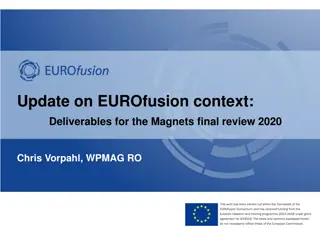
Intel Catastrophic Rx and IRMP in Medicare Part D Plan
Learn about Intel's Catastrophic Rx and IRMP benefits for retirees and eligible dependents enrolled in a Medicare Part D Plan. Discover how these programs help cover prescription drug costs and how to take advantage of them.
Download Presentation

Please find below an Image/Link to download the presentation.
The content on the website is provided AS IS for your information and personal use only. It may not be sold, licensed, or shared on other websites without obtaining consent from the author. If you encounter any issues during the download, it is possible that the publisher has removed the file from their server.
You are allowed to download the files provided on this website for personal or commercial use, subject to the condition that they are used lawfully. All files are the property of their respective owners.
The content on the website is provided AS IS for your information and personal use only. It may not be sold, licensed, or shared on other websites without obtaining consent from the author.
E N D
Presentation Transcript
Intel Catastrophic Rx HRA - IRMP February 2020
What is Intel Catastrophic Rx? Retirees and your eligible dependents enrolled in a Medicare Part D Plan can take advantage of Intel s Catastrophic Rx HRA. 2020 Medicare Part D Standard Benefit 1. Deductible $435 The Catastrophic Rx HRA will reimburse you for the 5% coinsurance you pay after you have met your annual true out-of-pocket maximum. 2. Initial Coverage Limit of $4,020/ You pay 25% coinsurance 3. Donut hole/Coverage gap you pay 25% Retirees do not need to enroll or elect this benefit, but you (or your eligible dependent for whom you are seeking reimbursement) must be enrolled in a Medicare Part D Plan. 4. True Out of Pocket $6,350 5. Catastrophic Coverage you pay 5% coinsurance For total drug costs above the catastrophic threshold, Medicare pays 80%, plans pay 15%, and enrollees pay either 5% of total drug costs or $3.60/$8.95 for each generic and brand-name drug, respectively. To take advantage of this benefit, you simply need to call the Intel Health Benefit Center at 877-GoMyBen (466-9236) and select the Your Spending Account option to notify the team you have exceeded the Medicare Part D Donut Hole. Your Spending Account representative will walk you through what you need to do to submit claims for reimbursement. IMPORTANT: All eligible dependents including domestic partners must be listed as your dependent on the My Health Benefits website in order for Catastrophic Rx reimbursement to be processed for their eligible expenses.
An example of the CMS model or standard plan Standard Medicare Part D Example 1) Annual deductible: You pay 100% of the cost up to the plan deductible amount. For example, let us assume that your total yearly prescription drug expenses are $7,080. Not all Part D plans have a deductible. 1. Annual Deductible and Initial Coverage Limit If your plan does not have a deductible, your coverage starts with the first prescription you fill. You will pay the first $435 yourself (as the Medicare Part D Plan deductible). After your deductible, you will pay 25% co-insurance towards all your prescription drug costs up to the initial coverage limit of $4,020. Therefore, you will pay 25% of the difference between the deductible ($435) and the total of the initial coverage period ($4,020 - 435)*.25 = $896.25. 2. Initial coverage: You pay copays or coinsurance up to a set limit You stay in this stage until your total prescription drug costs (what you pay and what your plan pays) reach $4,020 in 2020. 3. Coverage gap (the donut hole): You pay 25% of the costs. 3. Coverage Gap (Donut Hole) For generic & brand drugs you pay 25% of the costs. Once you reach the coverage gap, you'll pay no more than 25% of the cost for your plan's covered prescription drugs. You pay a percentage of the cost in this stage until you reach an out-of- pocket limit $6,350 in 2020. (annual OOP)6,350 4,020 (initial coverage limit) = 2,330*.25 (coinsurance) = $582.50 (your costs) 4. Catastrophic coverage: You pay a small coinsurance or copay amount. 4. Catastrophic Coverage You are in this stage for the rest of the Part D plan year. Once you've spent $6,350 out-of-pocket in 2020, you're out of the coverage gap. Once you get out of the coverage gap (Medicare prescription drug coverage), you automatically get "catastrophic coverage." It assures you only pay a small Coinsurance amount or Copayment for covered drugs for the rest of the year. Example explains Medicare Part D in CONCEPT only. Actual experience will vary based on Medicare Part D plan enrollment
Difference between CatRx and IRMP w/RX Formulary (list of covered drugs) IRMP formulary is very rich. Same formulary as an active employee Medicare part D plans have limited formularies Cost IRMP w/Rx provides dollar one coverage (retirees don t have to meet the deductible prior to getting RX coverage) IRMP w/Rx is a set cost of copay (see below for 2020) IRMP w/Rx monthly premium is high $500/month Medicare Part D plans can be purchased for $0 to moderately priced monthly premium You cannot use your Intel CatRx benefit until after you have exceeded the Medicare Part D Donut Hole $6,350.
How Do I Activate the CatRx Account? Before submitting any claims, an account must for be activated for you. The activation form is available on the YSA website or by calling YSA. You will need to complete the form and provide an explanation of benefits (EOB) showing that you have reached the catastrophic coverage phase. After confirming you ve reached the catastrophic coverage stage of your Medicare Part D plan, your account will be activated for you. You can then submit claims for your out-of-pocket prescription costs incurred from the date you met the catastrophic coverage stage through the end of the year. Claims incurred during your eligibility period must be submitted to YSA by March 31st of the following year. Instructions for filing claims can be found in the Knowledge Center portion of the YSA website. NOTE: Because your Medicare limits reset each year, you will need to submit a new activation form annually after you ve reached the Medicare Part D.
How Do I Receive CatRx Reimbursement? After your account is activated, eligible prescription expenses can be submitted online via the YSA website. Additionally, a paper claim form is available for download on the YSA website or may be obtained by calling YSA or Aon Retiree Health Exchange. With each claim form, you ll need to provide an itemized receipt that shows the following: Service provider s name; Date of service; Description of service; Who the service is for; and The out-of-pocket amount year are claiming for reimbursement As with other claims, EOBs from your insurance carrier are also acceptable forms of supporting documentation for out-of-pocket expenses. Note: the Catastrophic Prescription Drug Benefit can only be used to reimburse prescription expenses for the person that reaches the catastrophic coverage stage of their prescription plan. It cannot be used to reimburse expenses for other dependents.
Resources Intel Health Benefits Center IRMP Medical Coverage Call 800-468-3510 or visit Cigna online at www.mycigna.com. For answers to your questions about: Annual Enrollment IRMP medical and vision SERMA Catastrophic Rx HRA Aon Retiree Health Exchange Prescription Drug Coverage Call Express Scripts at 800-899-2713 or visit Express Scripts online at www.express- scripts.com/intel. Online resources available at www.intel.com/go/myben Medicare Call 800-633-4227 or visit Medicare online at www.medicare.gov. or via phone at 877-GoMyBen (466-9236) Health Insurance Marketplace Call Aon Retiree Health Exchange at 877-GoMyBen (466-9236); https://www.healthcare.gov and http://kff.org/health-reform/.




















